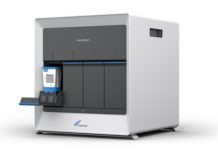An experimental drug is more than twice as effective as the standard treatment at reducing a key measure of severity in a rare kidney disease. This is the finding of a phase II clinical trial published online October 25 in the Journal of the American Society of Nephrology.
The new study found that patients with focal segmental glomerulosclerosis (FSGS), who took the drug sparsentan, saw a 45 percent reduction in proteinuria—an excess of protein in the urine that suggests poor kidney health. This compared to a 19 percent reduction in the group receiving the typically prescribed irbesartan.
“This is the first large-scale clinical trial of a treatment designed specifically to target FSGS, a rare disorder estimated to affect up to 40,000 people in the United States, and for which there are currently no approved therapies,” says principal investigator and lead study author Howard Trachtman, MD, professor in the Department of Pediatrics at NYU School of Medicine and director of the division of pediatric nephrology at Hassenfeld Children’s Hospital at NYU Langone. Nearly half of affected patients will progress to end-stage kidney disease, he says.
“Not only could sparsentan become part of the standard of care for patients with FSGS, but there are potential implications for any patient with kidney disease characterized by proteinuria—including the more common IgA nephropathy—which affects hundreds of thousands of people worldwide,” says Dr. Trachtman.
Nephrologists use proteinuria as a measure, or marker, of the health of patients with FSGS. When healthy, the kidneys filter blood, divert waste into urine, and return useful proteins to the bloodstream. FSGS, along with more common kidney diseases, damage the kidney’s filtering units, with proteins passing through and entering the urine to cause scarring in kidney tubules.
With no approved treatments for FSGS, the field has sought to use medications developed to treat other diseases, says Dr. Trachtman, including angiotensin II receptor blockers (ARBs), such as irbesartan. Initially developed to treat high blood pressure, ARBs are currently used in lieu of an approved FSGS therapy. These drugs act by lowering the blood pressure within the filtering units of the kidney and reducing kidney scarring.
New Approach
For the new study, researchers enrolled 109 patients with FSGS, ages 8 to 75 in the United States and 18 to 75 in Europe, in a randomized, double-blind, active-controlled trial (DUET) across 44 sites to assess the efficacy and safety of sparsentan. Participants were assigned either escalating doses of sparsentan (200, 400, or 800 mg per day) or irbesartan in 300 mg per day doses over 8 weeks. After completing the double-blind, eight-week treatment period, patients were able to continue to receive sparsentan in an open-label treatment period.
The study medication sparsentan works both as an angiotensin II receptor blocker, such as irbesartan, and as a blocker of the action of a second protein, endothelin receptor type A (ETA). The study authors had hypothesized that the two actions would together limit the production of molecules that lead to kidney scarring more than irbesartan’s single mechanism.
Sparsentan was indeed found to be more effective, and also to have very few serious side effects, with the most common—low blood pressure, dizziness, and swelling—similar in both groups. The research team also found that combining effects in a single molecule increased patients’ likelihood of taking their treatment because it reduced the number of pills.
Further study is needed to determine the long-term effects of sparsentan on preservation of kidney function, say the authors. In addition to the open-label treatment period of DUET, a phase III clinical trial (DUPLEX) is actively enrolling patients to determine if sparsentan brings about a sustained reduction of proteinuria.
“The prevalence of FSGS is on the rise, and this combined therapy could offer new hope for patients with this rare kidney disorder who currently face a progressive decline, a high chance of end-stage kidney disease, dialysis or transplantation,” says Dr. Trachtman.
In addition to Dr. Trachtman, study coauthors include Olga Zhdanova, MD, in the Department of Medicine, Division of Nephrology at NYU Langone; Peter Nelson, MD; Sharon Adler, MD; Kirk N. Campbell, MD; Abanti Chaudhuri, MD; Vimal K. Derebail, MD; Giovanni Gambaro, MD, PhD; Loreto Gesualdo, MD; Debbie S. Gipson, MD; Jonathan Hogan, MD; Kenneth Lieberman, MD; Brad Marder, MD; Kevin E. Meyers, MD; Esmat Mustafa, MD; Jai Radhakrishnan, MD; Tarak Srivastava, MD; Miganush Stepanians, PhD; Vladimir Tesar, MD; and Radko Komers, MD, PhD, on behalf of the DUET study group.
Sparsentan is manufactured by Retrophin, Inc., the biopharmaceutical company that funded the current clinical trial. Dr. Trachtman served as an unpaid consultant for Retrophin, has reported receiving consultancy fees from Kaneka Inc., Otsuka, and ChemoCentryx and was a consultant in the past to Genzyme and Optherion. All relationships are being managed in accordance with the policies of NYU School of Medicine.
















